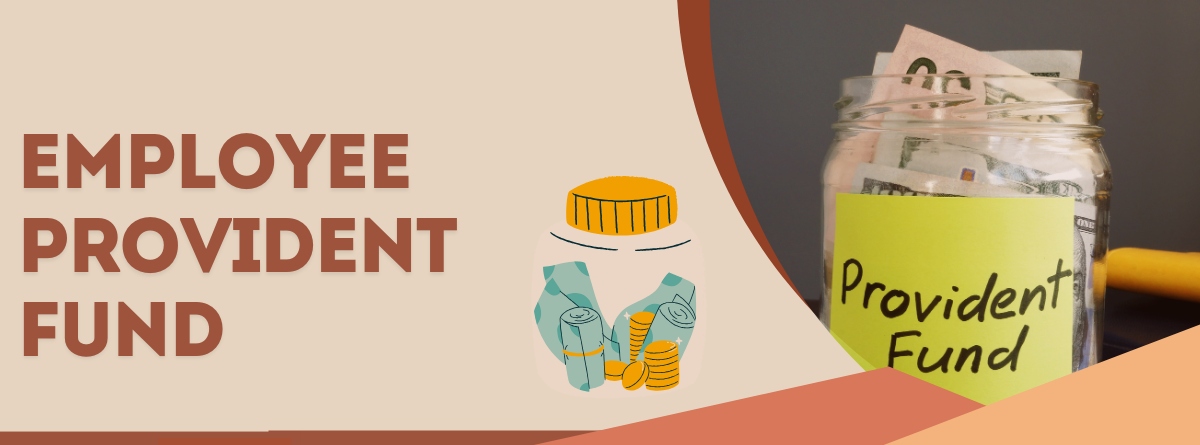Employee Provident Fund (EPF)
5paisa Research Team
Last Updated: 21 Jun, 2024 01:38 PM IST

Content
- What is EPFO (Employee Provident Fund Organisation)?
- Schemes Offered Under EPFO
- Objectives of EPFO
- UAN and EPFO Portal
- Employee Provident Fund (EPF) Eligibility
- EPF Interest
- EPF Calculation?
- How Is Interest on EPF Calculated?
- EPF Form
- Process of Transferring EPF Money
- EPF Benefits
- EPF Withdrawal Process
- EPF TAX Rules
- EPFO Information for Grievance
The EPF scheme, launched in 1951, caters to more than fifty million individuals. It is a welfare scheme governed by The Employees' Provident Scheme Act 1952, the Employees' Direct Linked Insurance Scheme Act 1976 and the Employees' Pension Scheme Act 1995.
EPF Employees’ Provident Fund is a savings scheme introduced by the Employees' Provident Fund Organisation and supervised by the Ministry of Labour and Employment, Government of India. The fund aims to facilitate a habit of savings among salaried employees and build a substantial retirement fund.
Under the scheme, the employer and employee contribute towards the fund. Interest periodically accrues on the investment amount. The corpus is available to the employee on retirement or exit from employment, subject to certain conditions. The schemes offered to extend to Indian workers. Additionally, workers from countries with signed bilateral agreements are eligible. In the case of a deceased employee, the dependents enjoy the scheme's benefits.
More About Savings Schemes
- Section 194IC
- PF Form 11
- Form 13 For PF Transfer
- EPF Form 20
- Corporate Fixed Deposit
- Fixed Deposit (FD) vs Recurring Deposit (RD)
- Income Tax on Recurring Deposit RD
- How to Withdraw Money from Unclaimed EPF Account
- How to Get Your Name Changed in the EPF
- Steps to Upload KYC for EPF UAN
- EPF Payment
- Difference between GPF, EPF, and PPF
- Difference Between APR vs APY
- Atal Pension Yojana Tax Benefits
- How To Open Atal Pension Yojana (APY) Account Online
- How to Close Atal Pension Yojana Account
- How to Change Details in Atal Pension Yojana Scheme
- NPS v/s SIP
- NPS Lite Aggregators List
- NPS Customer Care Number
- National Pension Scheme for NRI
- National Pension Scheme (NPS) Withdrawal Rules
- Best Child Investment Plans In India
- Post Office PPF Account
- PPF Account Withdrawal Rules
- PPF Deposit Limit
- PPF Account Age Limit
- PPF Account for Minors
- PPF Online Payment
- ELSS Vs PPF
- Loan Against PPF
- Post Office PPF Interest Rate
- PPF Interest Rates 2023 - 24
- What is Pradhan Mantri Jan Arogya Yojana
- Balika Samridhi Yojana
- What is member ID in PF?
- How To Merge Two UAN Numbers Online
- How to Merge Two PF Accounts?
- How to Raise Grievance in EPFO
- How to Check PF Balance in Mobile: A Comprehensive Guide
- How to Download Your EPF Passbook: A Comprehensive Guide
- TDS on PF Withdrawals: A Comprehensive Guide
- How to Transfer Your PF from One Company to Another?
- EPF vs PPF
- PF Balance Check with UAN Number Without Password
- PF Balance Check without UAN number
- Introduction to Savings Schemes
- Difference Between VPF And PPF
- EPF Form 10D
- NPS vs PPF
- Superannuation Meaning: What is Superannuation
- What is Fixed Deposit?
- Pradhan Mantri Awas Yojana
- Atal Pension Yojna vs NPS
- NPS (National Pension Scheme Charges)
- EPF vs EPS
- EPF Form 2
- What are Tier 1 and Tier 2 in NPS?
- NPS Tier 2
- NPS Tier 1
- Senior Citizen Saving Scheme (SCSS)
- General Provident Fund (GPF)
- Pension Fund Regulatory & Development (PFRDA)
- SBI Annuity Deposit Scheme
- GPF Interest Rates 2023
- Unit Link Insurance Plan (ULIP)
- List of Bank Mergers
- PRAN Card
- Foreign Currency Non Resident Account (FCNR)
- What is EDLI?
- What Is NPS Interest Rates?
- What is Form 15g
- Saksham Yuva Yojana
- Why Invest in PPF?
- How To Check PPF Account Balance
- NSC Interest Rate
- NSC – National Savings Certificate
- Swavalamban Pension Yojana
- KVP Interest Rate
- PF Withdrawal Rules 2022
- NPS Returns
- National Pension Scheme (NPS)
- Jeevan Pramaan Patra - Life Certificate for Pensioners
- Kisan Vikas Patra (KVP)
- PF Form 19
- PF Withdrawal Form
- EPS - Employee Pension Scheme
- PPF Withdrawal
- Atal Pension Yojana (APY)
- EPF Form 5
- EPF Interest Rate
- Check Your PF Balance Online
- Employee Provident Fund (EPF)
- UAN Registration & Activation Online
- UAN Member Portal
- Universal Account Number
- National Savings Scheme
- Post Office Tax Saving Schemes
- Post Office Monthly Income Scheme
- Post Office Savings Schemes
- EPF Claim Status
- EPF Form 31
- EPF Form 10C Read More
Disclaimer: Investment in securities market are subject to market risks, read all the related documents carefully before investing. For detailed disclaimer please Click here.
Frequently Asked Questions
The employers cannot reduce the share of EPF contribution. Such a reduction is a criminal offence.
The employee must reach out to the employer in such a case. If the employer cannot help, the employee may approach the Regional Provident Fund Commissioner of the PF office.
An apprentice cannot become a member of the EPF. However, an apprentice is eligible to enrol for EPF on completion of the apprenticeship.
There is no age restriction for an employee to become a member of the Provident Fund. Although an employee over the age of 58 cannot become a member of the Pension Fund.
The EPF contribution is a function of the salary paid in a calendar month.
According to tax rules, the employee’s contribution is eligible as the deduction under the section 80C. But the employer’s contribution is exempt to 12% of the salary.
You need to visit the official website & enter UAN, password, as well as captcha. Then, tap on the online service tab and select the claim option. Now, you can enter the bank account number that is linked to the PF account & tap on Verify.
One needs to check the PF status and in case of any issue, one can rectify them and re-submit.
The employee contribution is 12% of the basic salary, which is calculated on daily or monthly wage.
No, once the employee quits, the employee would not contribute to EPF.
Under the EPF act, the age limit is 58 years or beyond when no contributions will be accepted.


